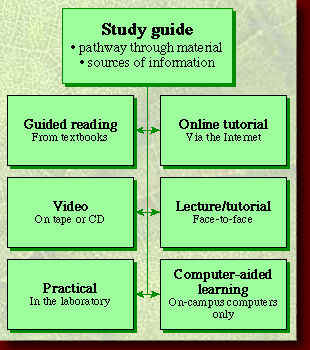Learning materials – The Biology of Plant Production
A large and complex project developing a semester-long subject for multimodal (blended) delivery to students in the first semester of applied science courses in agriculture, horticulture, natural resource management.
Most of the students were on-campus for the semester but some had only a mid-semester residential session. This project involved six staff teaching across two courses at three campuses; these staff had no prior experience of online delivery.
Funding requirements were determined, the funding proposal written and steered through the various assessment processes until it was granted. A strong and strategic client-outcome focus was essential to justifying the time and money involved. A thorough analysis established the content to be delivered and the needs of the students and industry. Fall-back strategies were identified in case they were needed.
The diversity of potential media for content delivery and the freedom of students to move between them allowed the teaching staff the opportunity to utilize the best materials, rather than being confined to a particular medium. Flexibility was further enhanced by moving from lecture-based teaching to a facilitated learning model.
In the final product, a comprehensive learning guide outlines each week’s material including the learning objectives, a clearly-structured pathway through the content, the sources of each piece of information (e.g. computer-based video, online, textbook or laboratory) and how the components are connected to form a cohesive picture.
The primary information was delivered via guided reading from prescribed textbooks, computer-based video, online simulation and online guide questions undertaken by the students in their homes (via a learning management system). These were followed up with face-to-face sessions that were reserved (primarily) for loosely-structured workshop discussions and laboratory classes (these dynamic and highly interactive aspects generally being best handled by direct contact).
Most of the online materials were created especially for the project. However, where high quality materials were already available online (anywhere in the world), they were contextualized and utilized, rather than reinventing them.
The workshops were vital to integrating the new content with prior learning and experience as well as engaging the students and conveying the excitement of the new material. Furthermore, there was opportunity for staff to receive quick feedback on materials and to cater for different learning styles.
An important part of the assessments was testing application of knowledge (rather than just the fundamental information), with students being asked to bring knowledge to bear on new situations.
One of the vital requirements of the development was to have transparent technology, so that students could concentrate on the learning rather than dealing with technical problems. This requirement was complicated by technical considerations with a substantial cohort of students being located rurally (with inherent communication problems) or working on older computers. A consistent and obvious interface was employed to aid novice web users.
Despite these potential problems and the initial apprehension of some students, online support and a couple of personal discussions with a handful of students resolved all problems rapidly. Personal and formal reports evidenced the increased ICT literacy of the students generally and, for some, the conquest of fears.
The design and presentation of the subject was assessed by informal discussion, focus groups, interview and anonymous questionnaire with subsequent detailed analysis. Because of the short development time, online materials were being produced just in time; perhaps the single benefit of this was the ability to use informal feedback to improve subsequent materials.
The students’ responses were extraordinarily positive (both verbally and in the formal quality of teaching questionnaires): most students’ quickly grasped the power of the multimodality so that motivation was high, with performance in summative assessments exceeding that of prior years. The staff, too, were motivated by the opportunities to have dialogue in the classroom rather than the one-way transfer of information that typifies the lecture. It was reported that a high-level meeting had hailed the subject as the best in the Faculty’s new courses.
The success of this subject demonstrated to staff and students the effectiveness of powerfully using ICT, a message that could be taken into other subjects and into more general life.
Although the development timeline was halved due to administrative delays, the product was delivered on time and under budget.
Apart from my role in chairing the content development, I created most of the resulting online materials, the study guides and CD-based videos. I also co-ordinated aspects of the project that required a graphic artist and programmer and directed a team of research assistants who handled some major copyright issues. Towards the end of the semester, I oversaw the devising of a questionnaire (separate from the quality of teaching questionnaires) to examine many aspects of the subjects; I analyzed all of the resulting data.
I delivered this subject at my campus and co-ordinated the multicampus subjects. Prior to and throughout the development and delivery, I coached the other staff. At the same time, I co-ordinated, delivered and assessed five other Higher Education subjects (two by distance education) and one in TAFE, as well as supervising student projects and working on another large project (‘The Burnley Plant Directory’). I also held the role of laboratory manager with its associated organizational, budgetary, safety and personnel responsibilities.


